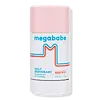What's inside
What's inside
 Key Ingredients
Key Ingredients

 Benefits
Benefits

 Concerns
Concerns

 Ingredients Side-by-side
Ingredients Side-by-side

Propylene Glycol
HumectantWater
Skin ConditioningSodium Stearate
CleansingSaccharomyces Ferment
Skin ConditioningPropanediol
SolventZea Mays Starch
AbsorbentParfum
MaskingHydrated Silica
AbrasiveRosa Damascena Flower Oil
MaskingSqualane
EmollientSalix Alba Bark Extract
AstringentCaffeine
Skin ConditioningArginine
MaskingAvena Sativa Kernel Flour
AbrasiveGlycerin
HumectantCamellia Sinensis Leaf Extract
AntimicrobialAloe Barbadensis Leaf Juice
Skin ConditioningSalvia Officinalis Leaf Extract
CleansingLeuconostoc/Radish Root Ferment Filtrate
AntimicrobialCocos Nucifera Oil
MaskingSilica Cetyl Silylate
Ethylhexylglycerin
Skin ConditioningHydrogenated Olive Oil Unsaponifiables
EmollientPhenoxyethanol
PreservativeSodium Benzoate
MaskingPotassium Sorbate
PreservativePropylene Glycol, Water, Sodium Stearate, Saccharomyces Ferment, Propanediol, Zea Mays Starch, Parfum, Hydrated Silica, Rosa Damascena Flower Oil, Squalane, Salix Alba Bark Extract, Caffeine, Arginine, Avena Sativa Kernel Flour, Glycerin, Camellia Sinensis Leaf Extract, Aloe Barbadensis Leaf Juice, Salvia Officinalis Leaf Extract, Leuconostoc/Radish Root Ferment Filtrate, Cocos Nucifera Oil, Silica Cetyl Silylate, Ethylhexylglycerin, Hydrogenated Olive Oil Unsaponifiables, Phenoxyethanol, Sodium Benzoate, Potassium Sorbate
Water
Skin ConditioningMandelic Acid
AntimicrobialMaranta Arundinacea Root Powder
Skin ConditioningTapioca Starch
Isoamyl Laurate
EmollientBehenyl Alcohol
EmollientHydrogenated Castor Oil
EmollientCaprylic/Capric Triglyceride
MaskingCaffeine
Skin ConditioningPvm/Ma Decadiene Crosspolymer
Potassium Hydroxide
BufferingGlyceryl Stearate
EmollientStearyl Alcohol
EmollientDimethicone
EmollientPanthenol
Skin ConditioningAloe Barbadensis Leaf Juice
Skin ConditioningTheobroma Cacao Seed Butter
EmollientTocopherol
AntioxidantAllantoin
Skin ConditioningStearic Acid
CleansingPalmitic Acid
EmollientCetyl Alcohol
EmollientLauryl Alcohol
EmollientMyristyl Alcohol
EmollientLecithin
EmollientPentylene Glycol
Skin ConditioningPhenylpropanol
MaskingSodium Benzoate
MaskingWater, Mandelic Acid, Maranta Arundinacea Root Powder, Tapioca Starch, Isoamyl Laurate, Behenyl Alcohol, Hydrogenated Castor Oil, Caprylic/Capric Triglyceride, Caffeine, Pvm/Ma Decadiene Crosspolymer, Potassium Hydroxide, Glyceryl Stearate, Stearyl Alcohol, Dimethicone, Panthenol, Aloe Barbadensis Leaf Juice, Theobroma Cacao Seed Butter, Tocopherol, Allantoin, Stearic Acid, Palmitic Acid, Cetyl Alcohol, Lauryl Alcohol, Myristyl Alcohol, Lecithin, Pentylene Glycol, Phenylpropanol, Sodium Benzoate
 Reviews
Reviews

Ingredients Explained
These ingredients are found in both products.
Ingredients higher up in an ingredient list are typically present in a larger amount.
Aloe Barbadensis Leaf Juice comes from leaves of the aloe plant. Aloe Barbadensis Leaf Juice is best known for helping to soothe sunburns. It is also anti-inflammatory, moisturizing, antiseptic, and can help heal wounds.
Aloe is packed with good stuff including Vitamins A, C, and E. These vitamins are antioxidants, which help fight free-radicals and the damage they may cause. Free-radicals are molecules that may damage your skin cells, such as pollution.
Aloe Barbadensis Leaf Juice also contains sugars. These sugars come in the form of monosaccharides and polysaccharides, folic acid, and choline. These sugars are able to help bind moisture to skin.
It also contains minerals such as calcium, 12 anthraquinones, fatty acids, amino acids, and Vitamin B12.
Learn more about Aloe Barbadensis Leaf JuiceCaffeine is most associated with coffee, tea, and cacao. In skincare, it helps with calming inflammation and is rich in antioxidants.
While caffeine is used to treat cellulite and and dark circles, further studies are needed to prove this. It has been believed to help with these skin conditions due to its ability to dilate blood vessels and increase blood flow.
Some studies are looking into caffeine's ability to protect against UV rays.
Learn more about CaffeineSodium Benzoate is a preservative. It's used in both cosmetic and food products to inhibit the growth of mold and bacteria. It is typically produced synthetically.
Both the US FDA and EU Health Committee have approved the use of sodium benzoate. In the US, levels of 0.1% (of the total product) are allowed.
Sodium benzoate works as a preservative by inhibiting the growth of bacteria inside of cells. It prevents the cell from fermenting a type of sugar using an enzyme called phosphofructokinase.
It is the salt of benzoic acid. Foods containing sodium benzoate include soda, salad dressings, condiments, fruit juices, wines, and snack foods.
Studies for using ascorbic acid and sodium benzoate in cosmetics are lacking, especially in skincare routines with multiple steps.
We always recommend speaking with a professional, such as a dermatologist, if you have any concerns.
Learn more about Sodium BenzoateWater. It's the most common cosmetic ingredient of all. You'll usually see it at the top of ingredient lists, meaning that it makes up the largest part of the product.
So why is it so popular? Water most often acts as a solvent - this means that it helps dissolve other ingredients into the formulation.
You'll also recognize water as that liquid we all need to stay alive. If you see this, drink a glass of water. Stay hydrated!
Learn more about Water